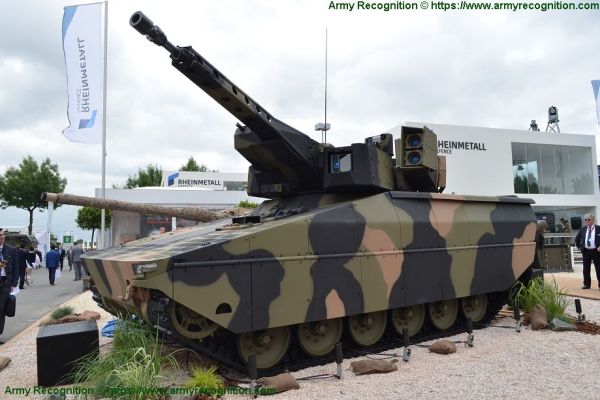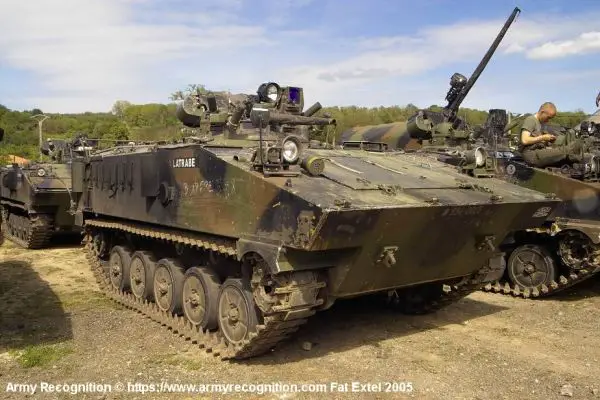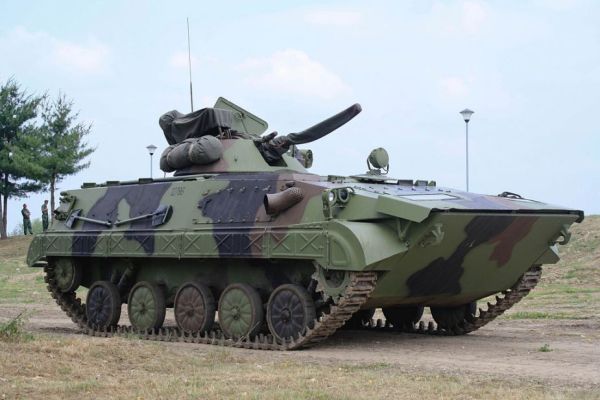TRACKED VEHICLES.
Borsuk IFV.

The Borsuk is a modern, amphibious tracked armored Infantry Fighting Vehicle (IFV) developed by Huta Stalowa Wola (HSW), a subsidiary of the Polish Armaments Group (PGZ). Conceived to replace the outdated BWP-1 fleet in the Polish Armed Forces, the Borsuk represents a substantial advancement in armored mobility, modular firepower, and network-enabled warfare. With amphibious capability, high survivability, and future-proof integration capacity, the Borsuk stands at the forefront of Poland’s mechanized modernization.
Country users: Poland
Description
The Borsuk IFV is a tracked, amphibious armored combat vehicle developed as part of Poland’s Nowy Bojowy Pływający Wóz Piechoty (NBPWP) program, initiated in 2014. Designed and manufactured by Huta Stalowa Wola (HSW), the vehicle was envisioned as a fully modern replacement for the BWP-1, offering advanced protection, mobility, and network integration suitable for contemporary and future battlefield conditions.
The initial technology demonstrator of the Borsuk was first unveiled at the MSPO 2017 defense exhibition. By 2018, a more refined version was presented, incorporating significant improvements such as side skirts, appliqué armor on the sides, and the adoption of composite rubber tracks (CRT) in place of earlier steel links. That same year, the prototype entered its first set of factory trials, resulting in further design enhancements. These were showcased at MSPO 2019, where a new trim vane, revised headlight arrangements, updated add-on armor, and mounting points for multispectral camouflage were introduced.
In September 2020, the prototype completed rigorous military field trials at the Drawsko Training Ground, which included live-fire assessments and environmental endurance testing. Concurrently, technical documentation was prepared to facilitate eventual production.
By November 2022, Borsuk was presented during formal evaluation and familiarization trials at the Orzysz Training Ground, witnessed by Poland’s Minister of National Defense, military officials, and media representatives. It was announced at the time that the 16th Mechanised Division would be the first operational unit to receive the Borsuk, pending successful completion of qualification trials, which were expected by mid-2023. It was also confirmed that the ZSSW-30 turret would be adaptable to other anti-tank guided missile systems and that the Borsuk chassis would serve as the foundation for a variety of specialized support vehicles.
On February 28, 2023, the Armaments Agency of the Polish Ministry of Defence signed a wide-ranging framework agreement with HSW for the delivery of 1,000 Borsuk IFVs and 400 support vehicles based on the same chassis. These auxiliary versions will include combat reconnaissance, command, armored recovery, medical evacuation (MEDEVAC), and NBC reconnaissance variants—illustrating the modular and scalable nature of the Borsuk platform.
At the MSPO 2024 exhibition, two new variants based on the Borsuk chassis were showcased for the first time: the standard IFV configuration and a prototype of a self-propelled mortar vehicle equipped with a demonstrator of the new M69 Rak turret. Notably, the mortar variant retains the full amphibious capability of the base platform, confirming the versatility of the chassis for fire support roles.
Finally, on March 27, 2025, the Polish Armaments Agency signed the first executive production contract with PGZ and HSW. Valued at 6.5 billion PLN (approximately 1.67 billion USD at the time), the agreement includes the delivery of 111 Borsuk IFVs scheduled between 2025 and 2029. This milestone marks the beginning of serial production and formal entry of the Borsuk into operational service with the Polish Armed Forces.
Poland’s defense ministry confirmed on December 4, 2025, that Polish Company Huta Stalowa Wola (HSW) has officially transferred the first tranche of Borsuk infantry fighting vehicles, a long-awaited milestone in a program that has drawn close attention across NATO. Polish officials described the handover as the start of a sustained fielding effort that will eventually push hundreds of new tracked vehicles into frontline battalions.
Borsuk IFV variants:
- Borsuk IFV: The standard infantry fighting vehicle configuration, equipped with the ZSSW-30 unmanned turret, featuring a 30mm Mk44S Bushmaster II autocannon, a 7.62mm UKM-2000C coaxial machine gun, and a dual Spike-LR anti-tank guided missile launcher. This variant is designed for transporting infantry troops while providing substantial fire support on the battlefield.
- Oset: A command vehicle variant designed to offer advanced command and control capabilities. It is equipped with enhanced communication systems to coordinate operations effectively within mechanized units.
- Żuk: A reconnaissance vehicle variant intended for battlefield surveillance and intelligence gathering. This version is likely to feature specialized sensors and communication equipment to relay critical information.
- Gekon: An armored recovery vehicle (ARV) variant tasked with the recovery and repair of damaged or immobilized vehicles in combat zones. It is expected to be equipped with cranes, winches, and other necessary recovery tools.
- Ares: A nuclear, biological, and chemical (NBC) reconnaissance vehicle variant designed to detect and analyze hazardous substances on the battlefield, ensuring the safety of troops from NBC threats.
- Rak: A self-propelled mortar variant equipped with the M69 Rak turret, housing a 120mm mortar system. This variant provides indirect fire support while retaining the amphibious capabilities of the base Borsuk chassis.
- Gotem: A medical evacuation (MEDEVAC) vehicle variant configured to transport injured personnel from the battlefield to medical facilities. It is designed to offer life-saving treatment during transit.
- Jodła GTRI: The Gąsienicowy Transporter Rozpoznania Inżynieryjnego (Tracked Engineering Reconnaissance Transporter) variant, intended for engineering reconnaissance missions to assess and prepare terrain for military operations.
- Jodła GTWI: The Gąsienicowy Transporter Wojsk Inżynieryjnych (Tracked Engineering Transporter) variant, designed to transport engineering units and equipment to support construction and fortification tasks in combat zones.
- Jodła TMN: The Transporter Minowania Narzutowego (Mine-Scattering Transporter) variant, aimed at deploying minefields rapidly to impede enemy movements. It is expected to replace the existing IMS Kroton system, with its mine-scattering mechanism likely based on the Baobab-K system.
- Jodła PTI: The Pływający Transporter Inżynieryjny (Amphibious Engineering Transporter) variant, intended to replace the PTS-M. This version is likely to feature a completely new hull utilizing components from the Borsuk platform to facilitate amphibious engineering operations.
Technical Data
-
Armament
The Borsuk’s primary weapon system is the ZSSW-30 remote-controlled turret, one of the most advanced modular combat systems in its class. Developed jointly by HSW and WB Group, the turret is designed for full digital integration with external command networks, as well as precision engagement across the full spectrum of land warfare threats.
Its main gun, the 30mm Mk44S Bushmaster II chain gun, offers dual-feed capability and is adaptable to future munitions, including programmable Air Burst Munitions (ABM) and next-generation smart rounds. The weapon delivers high accuracy and a consistent cyclic rate of 200 rounds per minute (standard) and 120 rounds per minute (ABM). Its elevated angle of fire, ranging from –9° to +60°, allows effective engagement in urban environments, mountainous terrain, and against low-flying aerial targets such as UAVs.
With 300 rounds of 30mm ammunition stored in the first-stage autoloader—over 200 of which can be ABM—the Borsuk provides one of the largest ready-to-fire ammo loads among NATO IFVs, ensuring prolonged engagement capability without immediate resupply. This is complemented by a 7.62mm UKM-2000C coaxial machine gun, with 250 rounds ready to fire, suitable for suppressing infantry and soft-skinned targets.
Anti-armor capability is provided by two Israeli-made Spike-LR ATGMs (Anti-Tank Guided Missiles) housed in an armored external launch pod on the turret’s right flank. Unlike retractable internal launchers, this modular pod design reduces risk to internal systems and enhances combat flexibility by enabling field-level replacement of damaged launchers. The Spike-LR offers precision strike at 4 km in manual mode and up to 4.5 km in fire-and-forget mode, with tandem-charge warheads capable of penetrating reactive and composite armor.
Importantly, all primary weapons can be reloaded from within the turret, and ATGMs are serviced through a rear hull hatch, allowing full rearmament under armor—a feature borrowed from the U.S. M2 Bradley and a notable enhancement for crew survivability during prolonged engagements.
-
Design and protection
The Borsuk's chassis is constructed from Armox 500T welded steel plates, utilizing a modular architecture that functions as spaced armor, maximizing deflection and absorption of kinetic energy. The baseline protection offers STANAG 4569 Level IV against 14.5mm AP projectiles from the front and Level III protection on the sides and rear, shielding against 7.62mm and artillery splinters. The underbelly protection meets Levels IIIa and IIIb for resistance to anti-tank mines and improvised explosive devices.
According to battlefield analysis and unofficial technical assessments, the frontal arc has resisted direct fire from Russian 30mm 3UBR6 and 3UBR8 rounds, indicating armor performance above standard NATO certifications. The sides reportedly resist 12.7mm and even 14.5mm AP rounds, though repeated impacts from the latter may compromise the engine bay. The vehicle is designed for up-armoring with modular armor kits, including appliqué frontal plates and side armor panels introduced post-2018, providing scalable protection based on threat environments.
Internally, the crew layout ensures survivability and situational functionality. The driver is positioned on the front-left, adjacent to the engine module on the right, with the unmanned ZSSW-30 turret centrally mounted to reduce exposure. The rear compartment seats six fully equipped infantrymen in blast-attenuating seats with rapid egress via an electrically operated rear ramp. This compartment is overpressurized and sealed, offering full NBC protection, ensuring crew survivability in chemically or radiologically contaminated environments.
The turret armor, though officially undisclosed, reportedly includes a composite matrix comprising polyethylene fabric sandwiched between ballistic steel plates, with alumina ceramic inserts on the ATGM container. This layered defense offers Level III protection to core systems and Level II for exposed components, such as optical sights. Add-on armor kits and camouflage nets can be mounted via pre-integrated external brackets, offering environmental adaptability.
-
Mobility
The Borsuk Infantry Fighting Vehicle is engineered for exceptional off-road agility and amphibious versatility, underpinned by a robust and highly efficient powertrain. At the heart of the platform is the MTU 8V199 TE20 turbocharged diesel engine, a compact yet powerful 8-cylinder unit delivering 720 horsepower. This engine is coupled to an advanced automatic transmission system that ensures smooth power delivery, rapid gear changes, and responsive acceleration across varied terrain types. With a combat weight of approximately 28 tonnes, the Borsuk maintains a favorable power-to-weight ratio of 25.7 hp/ton, enabling it to perform quick maneuvers and fast repositioning on the battlefield. The vehicle reaches a maximum road speed of 65 km/h and has an operational range of approximately 550 km, allowing for extended independent operation without logistical resupply.
The Borsuk utilizes a hydropneumatic suspension system, offering superior ride comfort, recoil dampening during firing, and adaptive terrain handling. This system also provides limited hull height adjustment, which is particularly useful for enhancing concealment in hull-down positions, reducing radar signature, or optimizing the vehicle’s waterline during amphibious operations. The suspension's dynamic response capabilities help to minimize crew fatigue and vehicle wear, making it highly suited for extended missions and rough-terrain operations.
The vehicle is supported by a conventional tracked running gear comprising six dual road wheels on each side. Drive sprockets are located at the rear, while idler wheels are mounted at the front, and multiple return rollers maintain proper track alignment. The Borsuk features composite rubber tracks (CRT), which provide quieter operation, lower ground pressure, and improved traction over mixed surfaces, compared to traditional steel tracks. This configuration supports efficient movement through mud, snow, and urban environments while reducing maintenance burdens.
Mobility performance is further enhanced by its trench-crossing and obstacle-clearing capabilities. The Borsuk can traverse trenches up to 2.6 meters wide and surmount vertical obstacles approximately 0.8 meters high. It can negotiate gradients of up to 60% and side slopes of approximately 30%, allowing it to operate confidently in hilly or uneven terrain.
A standout feature of the Borsuk is its full amphibious capability. Unlike many armored vehicles that require preparation for water operations, the Borsuk can enter and navigate aquatic environments immediately. Equipped with twin rear-mounted water jets, the vehicle maintains a stable and maneuverable profile in water, achieving a swimming speed of 8 km/h. This capability is crucial for operations in Poland’s riverine and marshy landscapes, allowing for seamless transition between land and water without compromising mission readiness or combat effectiveness.
Together, these mobility characteristics ensure that the Borsuk remains a highly versatile and strategically mobile IFV, capable of executing rapid deployment, supporting dynamic maneuver warfare, and operating across all terrains, including challenging amphibious and soft-soil environments.
-
Combat Equipment
he Borsuk’s combat systems are designed around network-centric warfare and automated threat response, making it a digital force multiplier in combined arms operations. Central to this capability is the ZSSW-30 fire control system (FCS) developed by WB Group. It provides full hunter-killer and killer-killer functionality, enabling independent target acquisition, tracking, and engagement by both the commander and gunner.
The FCS supports firing in all turret orientations, even while on the move, with target stabilization in all three axes. Auto-tracking, automatic ballistic computation, and fire permission logic are integrated into the commander's GOD-1 Iris and gunner’s GOC-1 Nike sights. Both sights include day and thermal imaging, eye-safe laser rangefinders, and light-intensity sensors, delivering precise targeting data under all visibility and weather conditions.
To supplement electronic vision systems, the Borsuk is equipped with a non-integrated optical backup sight located adjacent to the main sights for manual targeting in case of system failure.
The SOD (System Obserwacji Dookrężnej) 360-degree situational awareness system includes multi-spectral cameras for full environmental monitoring. Outputs are routed to displays for both crew and dismounts. Future iterations are planned to incorporate augmented reality interfaces and AI-driven target classification, greatly increasing battlefield awareness and reaction speed.
For active protection, the Borsuk features the Obra-3 soft-kill active protection system, comprising 12 laser warning receivers (four sets with three sensors each) covering 360° azimuth and –6° to +30° elevation. The system detects and differentiates laser-based threats—rangefinders, designators—and automatically responds by deploying GAk-81 phosphorus smoke grenades in the incoming laser path. Obra-3 can operate in manual, semi-automatic, or fully automatic modes, ensuring layered defense even during simultaneous multi-vector attacks.
For driver visibility, three front periscopes are augmented by a dedicated trim vane-mounted camera which activates during amphibious operations when conventional periscopes are obstructed.
Together, these systems make the Borsuk one of the most digitally advanced and situationally aware infantry fighting vehicles fielded within NATO, combining firepower, protection, mobility, and sensor fusion to dominate the modern battlespace.
Specifications
-
Armament
One 30mm Mk44S Bushmaster II automatic cannon, 7.62mm UKM-2000C coaxial machine gun, 2× Spike-LR anti-tank guided missiles, 8× 81mm GAk-81 smoke grenade launchers
-
Country users
Poland
-
Designer Country
Poland (Huta Stalowa Wola – HSW, part of Polish Armaments Group – PGZ)
-
Combat Equipment
GOD-1 Iris sight, GOC-1 Nike sight, auxiliary optical sight, WB Group fire control system, Obra-3 laser warning system, SOD panoramic observation system, multispectral cameras, NBC protection system
-
Crew
3 (driver, gunner, commander); Infantry: 6 dismounts
-
Armor
STANAG 4569 Level IV (front), Level III (sides and rear), Level IIIa/IIIb mine protection, modular applique armor, composite and ceramic armor on turret
-
Weight
Approximately 28 tonnes (combat weight)
-
Speed
65 km/h (road), 8 km/h (water)
-
Range
Approx. 550 kilometers
-
Dimensions
Length: 7.6 m; Width: 3.4 m; Height: 3.0 m















































